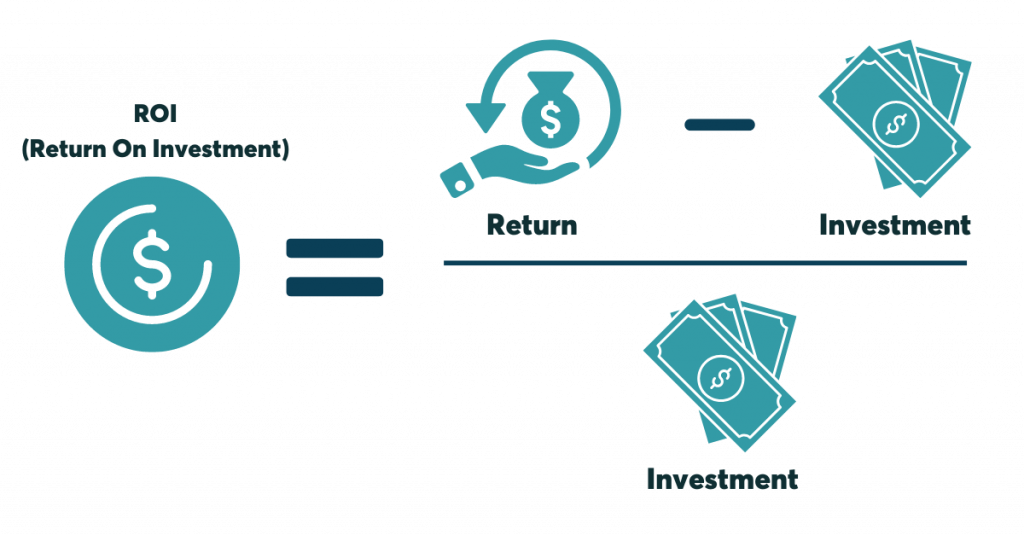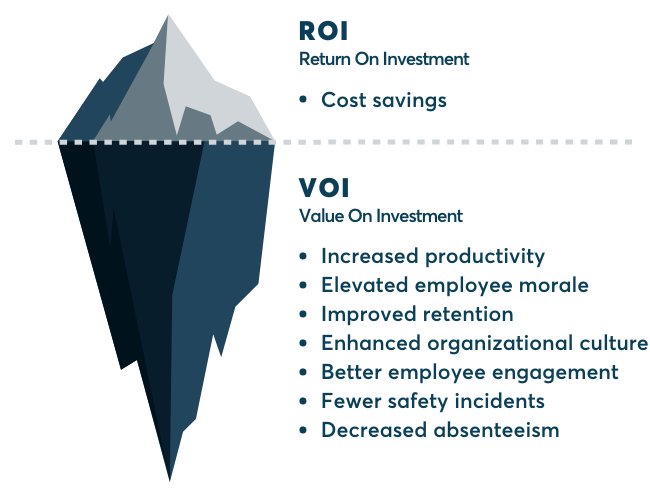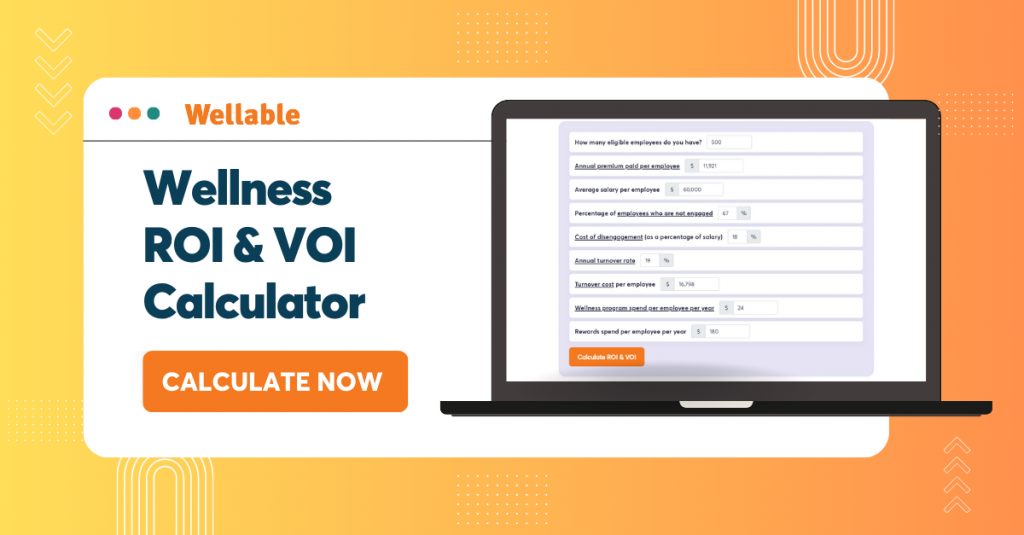Management often looks for returns to justify the financial and labor investment involved in running employee wellness programs, just as they would with other business initiatives. Two common perspectives are return on investment (ROI) and value on investment (VOI). This article covers the differences between ROI and VOI, the limitations of relying solely on ROI, and strategies to measure the true impact of wellness programs.
What Are The Benefits Of An Employee Wellness Program?

Employee wellness programs offer a multitude of benefits that contribute to a positive wellness program ROI and organizational success:
- Improve employee health: Regular wellness initiatives encourage healthier lifestyle choices and offer tangible strategies for improving physical health.
- Boost engagement and productivity: When employees feel their best, they perform their best. Engaged employees are more motivated, focused, and committed to their work, heightening productivity levels and indirectly boosting wellness program ROI.
- Alleviate stress: Mental health and stress management initiatives can significantly reduce workplace stress and improve mental well-being.
- Reduce absenteeism: Healthy employees are less likely to take sick days, ensuring consistent productivity. Reduced absenteeism impacts the wellness program ROI by lowering indirect costs related to lost workdays.
- Raise morale: Wellness programs can boost morale and job satisfaction, creating a more positive and self-motivated workforce.
- Support retention and recruitment: Companies that invest in their employees’ well-being tend to have lower turnover rates. This positively contributes to the wellness program ROI by eliminating costs associated with hiring and training new employees. A strong wellness program also makes an organization more attractive to job seekers who prioritize work-life balance.
- Build teamwork: Group wellness activities foster camaraderie and teamwork, resulting in improved collaboration and communication.
- Strengthen company image: Companies known for their commitment to employee wellness often enjoy a better reputation and stronger brand loyalty.
- Aid in managing high-cost health conditions: Wellness programs provide support and resources for managing chronic conditions, potentially reducing healthcare costs and increasing the wellness program ROI.
- Increase resilience: Wellness initiatives that focus on building resilience help employees cope with challenges and stressors at work and in their personal lives.
Calculating Return On Investment (ROI) For Wellness Programs
What Is ROI?

ROI is a financial metric used to evaluate the profitability of an investment, measuring the gain or loss generated relative to the investment’s cost. Traditionally, ROI has been a popular method for executives to justify wellness programs, especially for organizations focused on cost containment. One key measure of wellness program ROI is the reduction of healthcare claims and costs. However, ROI has its limitations, and research indicates that employers offer health and wellness programs for many reasons beyond just cutting healthcare costs.
Risks Of Measuring Wellness Programs By ROI Alone
To accurately measure the value of any corporate program, success metrics must align with the initiative’s overall goals. Employee wellness programs aim to improve overall well-being and cannot be fully evaluated by medical cost savings alone.
While reducing healthcare claims and costs is an important goal, it does not capture the complete value of wellness programs. Equally important benefits include increased employee productivity, improved morale, and reduced turnover. For example, initiatives like stress reduction and mindfulness may not show immediate financial returns but can significantly boost job satisfaction and employee engagement. These benefits, though challenging to quantify, are essential for employee well-being and contribute to a sustainable, successful organization.
Focusing exclusively on wellness program ROI can lead to a short-term mindset where employers seek quick returns on their investment, potentially overlooking programs that offer long-term benefits. Additionally, ROI calculations often ignore indirect costs, such as lost productivity due to absenteeism or presenteeism (when employees are present but not fully productive).
What Is VOI?

VOI is a comprehensive measure of all the benefits conferred by employee health and wellness programs. Focusing on VOI doesn’t exclude financial returns; rather, it encompasses additional metrics like productivity, employee morale, retention, and satisfaction, all of which impact an organization’s bottom line. Among employees with wellness programs, 89% report being happy with their job and would recommend the company to a friend. Only 17% would recommend a company that is not committed to improving workforce well-being.
By considering this broader context, companies can achieve a complete view of program effectiveness that encompasses more than just dollar-to-dollar cost. This perspective enables organizations to fine-tune their wellness programs and maximize success.
Some VOI metrics are easier to track than others, but few are impossible to track. Examples of VOI metrics include employee engagement, safety incidents, absenteeism, and turnover. Many companies already track this data but don’t analyze it in relation to workforce health. For example, there is a direct link between employee wellness programs and the all-important ability to attract and retain talent.
To summarize the difference between VOI and ROI, check out this Whiteboard Wednesday video:
VOI Wellness Metrics To Track
A company’s success depends on the health of its people. Anything that promotes a healthy lifestyle will naturally benefit many of an organization’s key performance indicators (KPIs). Below are a few ways in which these connections are directly validated.
1. Productivity
Productivity is the third most popular reason for investing in health. US employers spend about $530 billion due to productivity loss resulting from absenteeism and presenteeism.
There are other subtle effects of a less-than-optimally healthy workforce. For instance, one study reveals a link between obesity and riskier decision-making. Holistic wellness programs can help individuals manage their weight and improve cognitive function alongside other health benefits. Sitting for too long also leads to cognitive decline, and the availability of standing desks for employees can boost productivity.
Among employees with wellness programs, 62% felt their program boosted morale and increased productivity, while 56% reported having taken fewer sick days as a result. Stress and mental health also impact productivity: since stress hormones impair cognitive ability, knowing that paid sick leave is available can decrease employee stress levels.

Measuring productivity, however, is challenging. In theory, productivity can be calculated by dividing business outputs (calls made, services produced, etc.) by total number of employees. Only a few employees directly contribute to business outputs, while other departments work behind the scenes to keep the business running without directly impacting the products. Additionally, the quality of the output is as important as the quantity, adding another layer to the assessment.
Despite these challenges, measuring productivity is achievable. Many organizations now gauge productivity based on hitting departmental and personal goals using performance metrics like KPIs. Employees can also rate their own productivity levels. While self-reported data should be used with caution, combining it with other metrics can provide a more complete picture.
2. Recruitment/Retention

Replacing an employee costs between 20% and 213% of their annual salary, according to the Bureau of Labor Statistics. Today’s employees, especially millennials, look for a company that cares about their well-being …and backs up that care with concrete actions.
Employee retention increases when companies demonstrate that they care about healthy employees — this extends to workers who don’t make use of a wellness program. A survey found that 73% of employees without access to wellness programs want them, with 42% indicating they are “very interested.”
Compared to productivity, employee retention is much easier to track. The formula is relatively simple: divide the number of employees who stayed at the company during a period by the total number of employees at the start of a period to get the percentage.

Satisfaction
Research demonstrates that worker satisfaction closely correlates with whether or not an employer has a wellness program. Among employers offering wellness programs, 67% reported increased employee satisfaction, 66% reported increased productivity, 63% reported increased financial sustainability and growth, and 50% reported decreased absenteeism.
How To Improve VOI For Your Wellness Program
So, what’s the best way to optimize the VOI of wellness programs? In most cases, it is simply a matter of improving employee engagement and utilization in the wellness program. Several proven methods to achieve this include:
- Creating multiple channels of communication: Employees cannot participate in programs that they’re unaware of. Organizations can improve engagement by informing employees of the program through a broad range of communication channels, such as emails, internal communication tools, videos, flyers, push notifications, social media, etc. Generating excitement through word-of-mouth is another effective channel to recruit participants.
- Offering variety: Successful wellness programs provide a wide range of benefits to meet diverse employee needs. A strong program should include all dimensions of wellness, such as mental health, exercise, stress management, and financial wellness. These can be delivered through various types of programs such as webinars, activity tracking, challenges, and informational articles.
- Securing leadership support: One study found that organizations with leaders who publicly recognize healthy actions and model such behaviors are more likely to report employee health improvements and medical cost reductions. Leadership support is not just about fulfilling obligations; it creates a lasting culture of health within the organization.
Wellable Wellness ROI & VOI Calculator
Striking a balance between ROI and VOI can help a company accurately measure wellness program success. Recognizing this need, Wellable has introduced a Wellness Program ROI & VOI Calculator.
This tool goes beyond measuring ROI. It also reveals the broader VOI, including key non-financial benefits such as employee engagement, retention, and productivity. While traditional ROI offers insights into immediate financial gains, VOI paints a holistic picture, presenting a comprehensive perspective on the health and vitality of an employee wellness initiative.
This calculator is designed for adaptability using industry benchmarks and employee count to auto-populate assumptions. However, each organization is unique, so there’s an option to adjust these assumptions based on the company’s actual data.
Explore the Wellness Program ROI & VOI Calculator to quantify your program’s impact and redefine success.
ROI vs. VOI: In Conclusion, Which Is Better?
In the debate between VOI vs. ROI, it’s clear that both metrics have their place in evaluating the wellness program success. ROI provides a straightforward financial perspective, helping organizations understand the immediate cost benefits of their investments. However, VOI offers a more comprehensive view, encompassing not only financial returns but also improvements in productivity, morale, retention, and overall employee well-being.
Ultimately, the best approach is a balanced one that leverages both ROI and VOI. By combining these metrics, organizations can gain a holistic understanding of their wellness programs’ true impact, ensuring they invest in initiatives that deliver both immediate and long-term benefits.
This article was last updated on July 18, 2024














